I often speak of using angles in your drawings. Like so many other words, “angles” probably mean different things to different people. Some artists think of design as an important part of drawing, so when I mention angles, they may think of how an angle fits into the design. Some artists think of drawing as an anatomical depiction of a person or animal. Angle to them might refer to the proper angle of the clavicle from the sternum up to the shoulder (acromion part of the scapula), or how the angle of the forehead relates to the angle of the cheek. An artist who is involved in layout and composition might think of how the angles of the figure interact with the format of the borders or the background.
When I speak of angles, I am referring to gesture. In body language a slight change in the angle of the head, torso, arm, etc., can alter the meaning of the pose in sometimes subtle and sometimes blatant ways. For the purposes of animation (storytelling) we are interested in these graphic devices or tools. In comedy, even broad comedy, subtle nuances can be the difference between putting over a gag or story point in a laughable way or just a passable way.
The word angle has a kind of mechanical or geometrical intimation to it, but actually when they are used in gesturing they are more organic than mechanical. A very graceful person will sometimes use very acute angles to express a very dainty action or pose. Picture a petite, elderly lady drinking tea, with her back straight and at right angles to her legs; her hand and fingers that hold the cup are contorted into many acute angles, yet are the picture of delicacy. Take the cup out of her hand, turn the angle of the wrist inward instead of out, bend her forward, give her a cane and that same hand, with no more acute angles than when she held the tea cup, will conjure up images of arthritic pain.
The meaning of an angle of one part of the body will change as the angles of other parts of the body are altered. The relationships of angles can depict happiness, sadness, pain, fear, anger, etc. Yet many of the angles of the parts of the body are used in each of those emotions only in different combinations. The humor in a pose or action can be exploited by exaggeration or caricaturing those angles. As a matter of fact a slight bit of caricature is absolutely necessary in animation to keep the movements from looking stilted. You’re probably all aware of how bland animation appears when photostats of live action are literally traced onto animation paper. Live action actors can get away with an amazingly minimal amount of movement. There can be two people talking for long periods with hardly more than eye blinks, but that goes over like a lead balloon in animation.
Take a moment to study yourself right now. Notice the angles of your arms, legs, feet, etc. Most likely none of them are doing the exact same thing; that is, twinning. Each angle is the way it is because it is expressing something. Every time you move you create a whole new set of angles.
One of the hardest things to “put over” in the Tuesday and Wednesday evening classes is to stop straightening up the pose. We are raised with this “thing” about straightening things up: “straighten up your room,” “straighten that picture on the wall,” “straighten out your affairs,” “straighten up and fly right,” etc. We can’t stand men’s ties that are askew, or wine glasses that lean, or cars that list as they travel down the highway. So you come to class. The models go to such trouble to contort themselves into expressive poses, and what do you do? Straighten everything up. It’s okay to be neat — but not while drawing.
A study has shown that only seven percent of what is communicated between people is transmitted through the words themselves. Thirty-eight percent comes through the tone of voice. Fifty-five percent of communication, the largest part, is a result of physiology or body language. In the case of drawing from the model, one hundred percent of the communication is through body language. So it behooves us to slant things in the right direction, and get the whole one hundred percent out of the pose.
Well, have I straightened you out on this angle thing? I hope this gives you a new slant on drawing. Exploit those angles for all they’re worth, and believe me, they’re worth a lot.
Here is one of my corrections that exploits the angles of the hand, neck, back, hair, and hat brim, which I used to push his look to the object of his attention.

The angles of wrists and fingers are very expressive. A lot of times we gloss over them like they’re just some kind of growth on the end of the arms. In drawing, hands are worth more than tongues.

Angles plus a little squash and stretch will put a lot of nice tension, movement, and life into your drawings.

Intensifying the angles will get your audience to become more involved.

